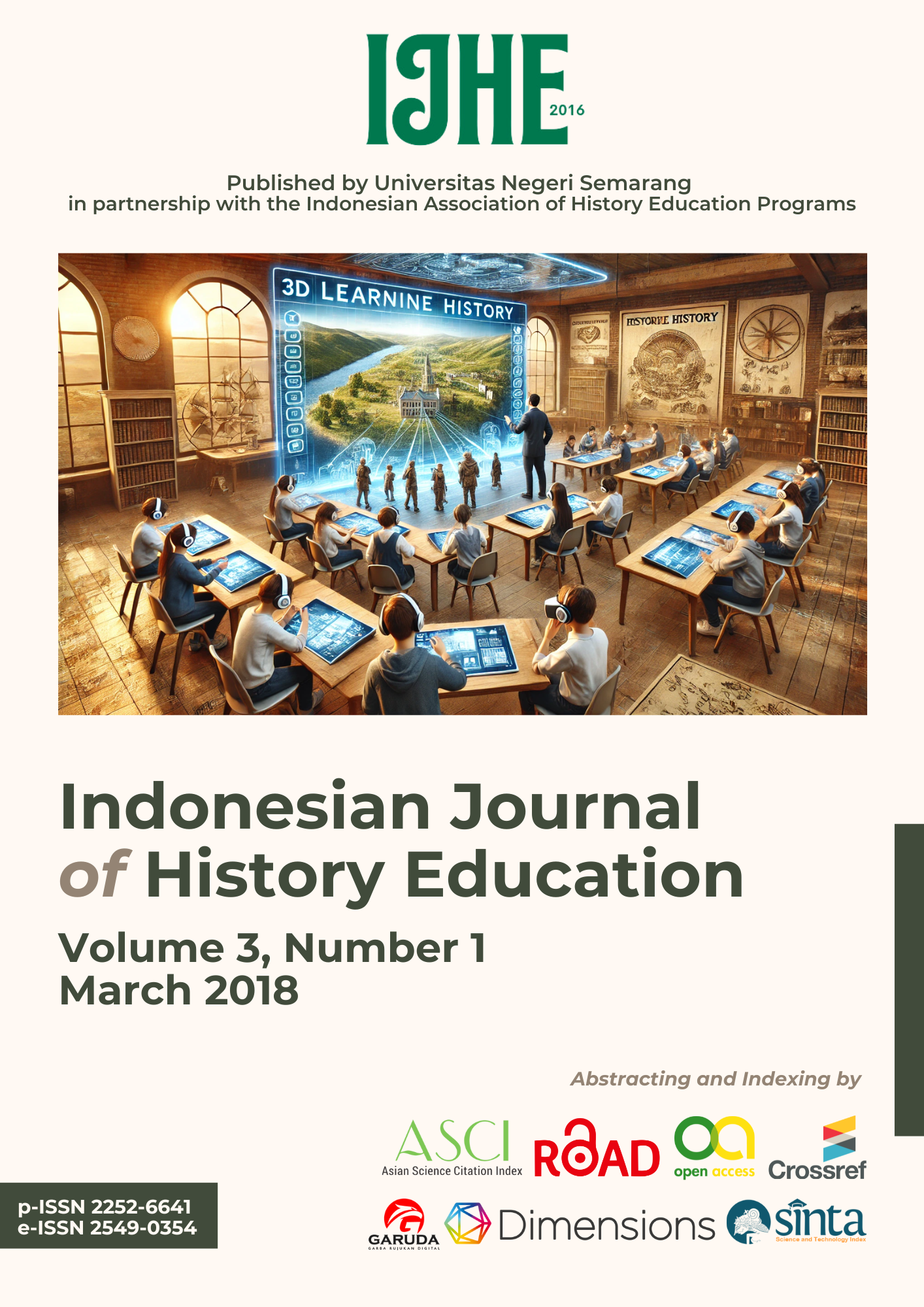Development of History Teaching Materials on Islamization Subjects Based on Historical Relics of the Great Mosque of Demak
Abstract
This study aims to explore the development of historical empathy in learning global diversity through qualitative research using a literature review method. The study identifies the formulation of the problem, selects relevant research, and maps the data to compile and report results. Findings define historical empathy and its role in shaping global diversity, proposing learning models like introduction, investigation, display, and reflection. Recommended resources include films or museum visits, tailored to specific learning materials. This research offers implications for history teachers to enhance students' historical empathy skills, emphasizing global diversity to foster tolerant, democratic, open-minded, and critical-thinking students. The study highlights the development of teaching materials integrating Islamic history and the Great Mosque of Demak, demonstrating improved student engagement, analytical skills, and cognitive outcomes through research and development methodology.
References
Arikunto, S. (2006). Dasar-dasar evaluasi pendidikan. Bumi Aksara.
Dolong, J. (2016). Teknik analisis dalam komponen pembelajaran. Inspiratif Pendidikan, 5(2), 293-300.
Hakim, A. (2010). Hypnosis in teaching: Cara dahsyat mendidik & mengajar. Visimedia.
Hamalik, O. (2002). Perencanaan pengajaran berdasarkan pendekatan sistem. PT Bumi Aksara.
Kochhar, S. K. (2008). Teaching of history: Pembelajaran sejarah. PT Grasindo.
Mulyasa, E. (2009). Menjadi guru profesional: Menciptakan pembelajaran kreatif dan menyenangkan. PT Remaja Rosdakarya.
Nurdin, M. (2008). Kiat menjadi guru profesional. Ar-Ruzz Media.
Nurgiyantoro, B. (2010). Penilaian pembelajaran sastra berbasis kompetensi. BPFe.
PaEni, M. (2009). Sejarah kebudayaan Indonesia: Seni rupa dan desain. Rajawali Pers.
Prastowo, A. (2012). Panduan kreatif membuat bahan ajar inovatif. Diva Press.
Purwanto. (2001). Penulisan bahan ajar. Proyek Pengembangan Universitas Terbuka, Direktorat Jenderal Pendidikan Tinggi, Departemen Pendidikan Nasional.
Putra, N. (2011). Research & development: Penelitian dan pengembangan: Suatu pengantar. Rajawali Press.
Rasyid, M. R. (2008). Optimalisasi peran guru dalam proses transformasi pengetahuan dengan menggunakan media pembelajaran. Lentera Pendidikan: Jurnal Ilmu Tarbiyah dan Keguruan, 11(1), 55-68.
Santosa, B. (2013). Peran guru dalam meningkatkan mutu pendidikan. Gramedia.
Santoso, B. (2015). Kompetensi guru dan pengaruhnya terhadap kualitas pendidikan. Media Edukasi.
Sepriady, J. (2016). Contextual teaching and learning dalam pembelajaran sejarah. Kalpataru: Jurnal Sejarah dan Pembelajaran Sejarah, 2(2), 100-110.
Sugiyono. (2010). Metode penelitian pendidikan. Alfabeta.
Suryana, D. (2015). Kompetensi guru dan kualitas pendidikan. Alfabeta.
Wahyudi, A. (2014). Profesionalisme guru dan dampaknya terhadap prestasi siswa. Pustaka Pelajar.
Wahyuni, A. (2013). Pengembangan kreativitas guru sebagai modal penerapan kurikulum 2013. UMSIDA.
Wasino. (2010). Materi diktat menyusun bahan ajar yang cerdas. Lembaga Pengawas Kualitas Pendidikan.
Wena, M. (2009). Strategi pembelajaran inovatif kontemporer: Suatu tinjauan konseptual operasional. Bumi Aksara.
Wibowo, W. (2012). Langkah kritis dan kontemporer: Menulis buku ajar perguruan tinggi. Bidik Phronesis Publishing.
Widja, I. G. (1989). Sejarah lokal suatu perspektif dalam pengajaran sejarah. Depdikbud.
Copyright (c) 2018 Fathimah Zahra

This work is licensed under a Creative Commons Attribution 4.0 International License.
Copyright Notice
An author who publishes in the Jurnal Indonesian Journal of History Education agrees to the following terms:
- Author retains the copyright and grants the journal the right of first publication of the work simultaneously licensed under the Creative Commons Attribution-ShareAlike 4.0 License that allows others to share the work with an acknowledgement of the work's authorship and initial publication in this journal
- Author is able to enter into separate, additional contractual arrangements for the non-exclusive distribution of the journal's published version of the work (e.g., post it to an institutional repository or publish it in a book) with the acknowledgement of its initial publication in this journal.
- Author is permitted and encouraged to post his/her work online (e.g., in institutional repositories or on their website) prior to and during the submission process, as it can lead to productive exchanges, as well as earlier and greater citation of the published work (See The Effect of Open Access).
Read more about the Creative Commons Attribution-ShareAlike 4.0 Licence here: https://creativecommons.org/licenses/by-sa/4.0/.




